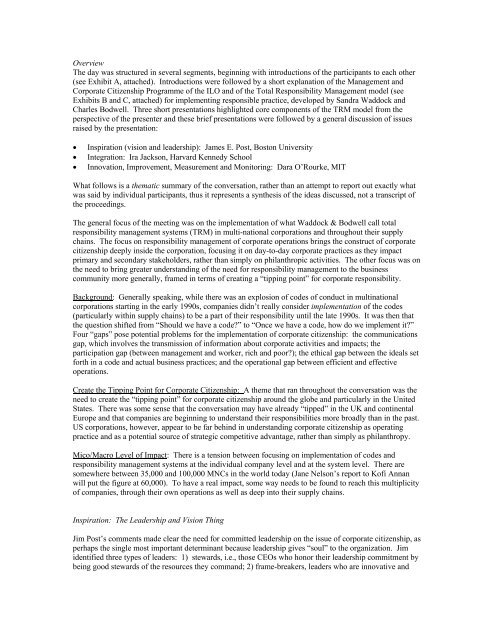The Challenges - International Labour Organization
The Challenges - International Labour Organization
The Challenges - International Labour Organization
Create successful ePaper yourself
Turn your PDF publications into a flip-book with our unique Google optimized e-Paper software.
Overview<br />
<strong>The</strong> day was structured in several segments, beginning with introductions of the participants to each other<br />
(see Exhibit A, attached). Introductions were followed by a short explanation of the Management and<br />
Corporate Citizenship Programme of the ILO and of the Total Responsibility Management model (see<br />
Exhibits B and C, attached) for implementing responsible practice, developed by Sandra Waddock and<br />
Charles Bodwell. Three short presentations highlighted core components of the TRM model from the<br />
perspective of the presenter and these brief presentations were followed by a general discussion of issues<br />
raised by the presentation:<br />
• Inspiration (vision and leadership): James E. Post, Boston University<br />
• Integration: Ira Jackson, Harvard Kennedy School<br />
• Innovation, Improvement, Measurement and Monitoring: Dara O’Rourke, MIT<br />
What follows is a thematic summary of the conversation, rather than an attempt to report out exactly what<br />
was said by individual participants, thus it represents a synthesis of the ideas discussed, not a transcript of<br />
the proceedings.<br />
<strong>The</strong> general focus of the meeting was on the implementation of what Waddock & Bodwell call total<br />
responsibility management systems (TRM) in multi-national corporations and throughout their supply<br />
chains. <strong>The</strong> focus on responsibility management of corporate operations brings the construct of corporate<br />
citizenship deeply inside the corporation, focusing it on day-to-day corporate practices as they impact<br />
primary and secondary stakeholders, rather than simply on philanthropic activities. <strong>The</strong> other focus was on<br />
the need to bring greater understanding of the need for responsibility management to the business<br />
community more generally, framed in terms of creating a “tipping point” for corporate responsibility.<br />
Background: Generally speaking, while there was an explosion of codes of conduct in multinational<br />
corporations starting in the early 1990s, companies didn’t really consider implementation of the codes<br />
(particularly within supply chains) to be a part of their responsibility until the late 1990s. It was then that<br />
the question shifted from “Should we have a code?” to “Once we have a code, how do we implement it?”<br />
Four “gaps” pose potential problems for the implementation of corporate citizenship: the communications<br />
gap, which involves the transmission of information about corporate activities and impacts; the<br />
participation gap (between management and worker, rich and poor?); the ethical gap between the ideals set<br />
forth in a code and actual business practices; and the operational gap between efficient and effective<br />
operations.<br />
Create the Tipping Point for Corporate Citizenship: A theme that ran throughout the conversation was the<br />
need to create the “tipping point” for corporate citizenship around the globe and particularly in the United<br />
States. <strong>The</strong>re was some sense that the conversation may have already “tipped” in the UK and continental<br />
Europe and that companies are beginning to understand their responsibilities more broadly than in the past.<br />
US corporations, however, appear to be far behind in understanding corporate citizenship as operating<br />
practice and as a potential source of strategic competitive advantage, rather than simply as philanthropy.<br />
Mico/Macro Level of Impact: <strong>The</strong>re is a tension between focusing on implementation of codes and<br />
responsibility management systems at the individual company level and at the system level. <strong>The</strong>re are<br />
somewhere between 35,000 and 100,000 MNCs in the world today (Jane Nelson’s report to Kofi Annan<br />
will put the figure at 60,000). To have a real impact, some way needs to be found to reach this multiplicity<br />
of companies, through their own operations as well as deep into their supply chains.<br />
Inspiration: <strong>The</strong> Leadership and Vision Thing<br />
Jim Post’s comments made clear the need for committed leadership on the issue of corporate citizenship, as<br />
perhaps the single most important determinant because leadership gives “soul” to the organization. Jim<br />
identified three types of leaders: 1) stewards, i.e., those CEOs who honor their leadership commitment by<br />
being good stewards of the resources they command; 2) frame-breakers, leaders who are innovative and

















